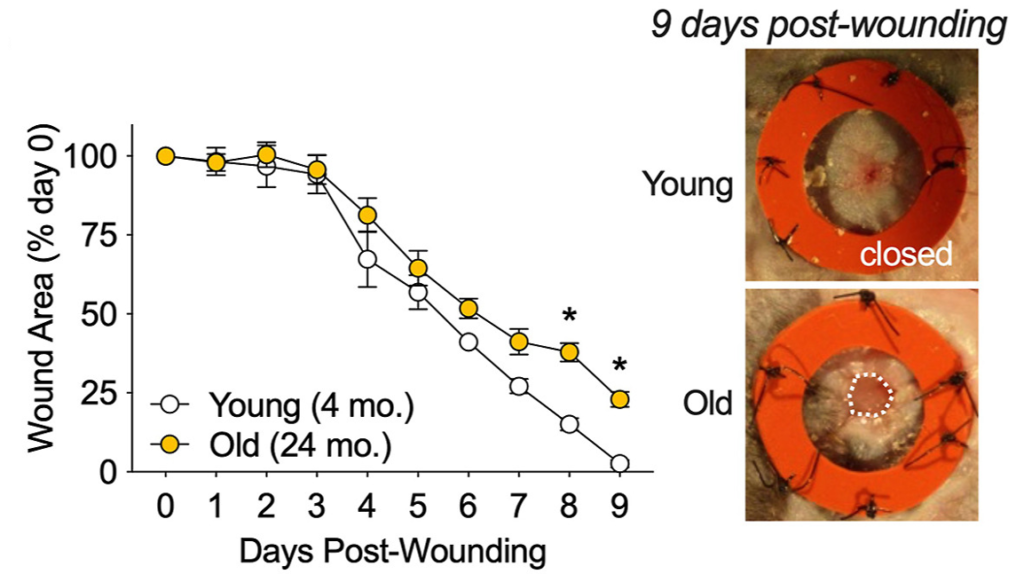New Study Finds NAD+ Precursors Promote Wound Healing by Leveraging Skin Regeneration
Scientists find that the NAD+ precursors nicotinamide, NR, and NMN increase skin regrowth in elderly mice
Highlights:
- Upon injury, the skin wounds of elderly mice do not fully heal like young mice.
- The regenerative capacity of skin from elderly mice is impaired, as shown by reduced cell proliferation.
- Nicotinamide, nicotinamide riboside (NR), and nicotinamide mononucleotide (NMN) restore elderly skin regrowth to youthful levels.
Poor wound healing in the elderly poses a unique problem, as effective wound-healing therapies are lacking. Now, scientists from Northeastern University in Boston and the University of Ottawa in Canada show that boosting nicotinamide adenine dinucleotide (NAD+) may help restore the skin’s regenerative capacity, prompting more efficient regrowth.
Wong and colleagues report in Molecular Metabolism that skin repair is mediated by NAD+. After confirming in mice that wound healing becomes slower with aging, the researchers show that the skin cells of elderly mice do not proliferate as much as young mouse skin cells. The investigators also observed low NAD+ levels, increased cell-cycle arrest, and alterations in NAD+-dependent enzymes in elderly skin. Finally, it is shown that three different NAD+ precursors restore skin regrowth.
NAD+ Promotes Skin Regrowth in Elderly Mice
To confirm that aging leads to defects in wound healing, Wong and colleagues punctured the skin of elderly 24-month-old (equivalent to 70 human years) and young 4-month-old (equivalent to about 23 human years) mice. While the wounds of the young mice fully healed after nine days, the wounds of the old mice did not fully recover.
The researchers next placed excised skin from the elderly mice into a dish (explant) and assessed skin regrowth. They not only found that regrowth was inhibited but also that cell proliferation was reduced. Since cell proliferation is needed to generate new skin cells, these findings suggest that wound healing is slowed in elderly mice due to reduced cell proliferation.

NAD+ is critical in cellular energy homeostasis and fuels enzymes important for DNA repair and cell survival, including sirtuins and PARPs. While PARPs are mainly involved in DNA repair, sirtuins modulate multiple cellular processes, such as cell proliferation. Specifically, decreased sirtuin activity is associated with cell-cycle arrest, which stops the division of cells and inhibits proliferation.
Wong and colleagues found that NAD+ levels were lower in the skin of elderly mice. Additionally, sirtuin activity was lower, and PARP activity was higher. Furthermore, cells positive for cell-cycle arrest were increased. Finally, by treating skin explants from elderly mice with three different NAD+ precursors, regrowth was restored to levels similar to young mice. These findings suggest that NAD+ restores sirtuin activity, prevents cell-cycle arrest, and promotes skin regrowth.

Overall, the findings of Wong and colleagues suggest that replenishing NAD+ in elderly mice can promote faster healing of the skin after injury. It seems that reduced sirtuin activity in elderly skin leads to cell-cycle arrest and decreased skin cell proliferation, which may underlie the slow wound healing exhibited by elderly mice. Refueling sirtuins with NAD+ may prevent cell-cycle arrest and increase skin cell proliferation to regenerate skin and heal wounds.
Preventing Skin Aging with NAD+ Precursors
NAD+ precursors like NMN have previously been shown to protect skin from the accelerated aging induced by particulate matter and reduce skin inflammation, which is also associated with aging. Along with the findings of Wong and colleagues, these animal studies suggest that NAD+ precursors like NMN can help with protecting the skin against aging. Furthermore, nicotinamide has previously been shown to reduce skin tumors in skin cancer patients, and it has been suggested that NR and NMN may do the same. As scientists continue to explore applications for NAD+ precursors, we may find them as a remedy for age-related skin ailments.

